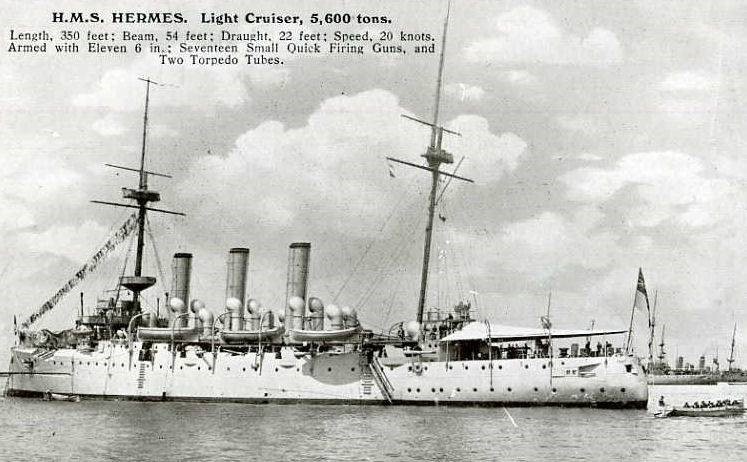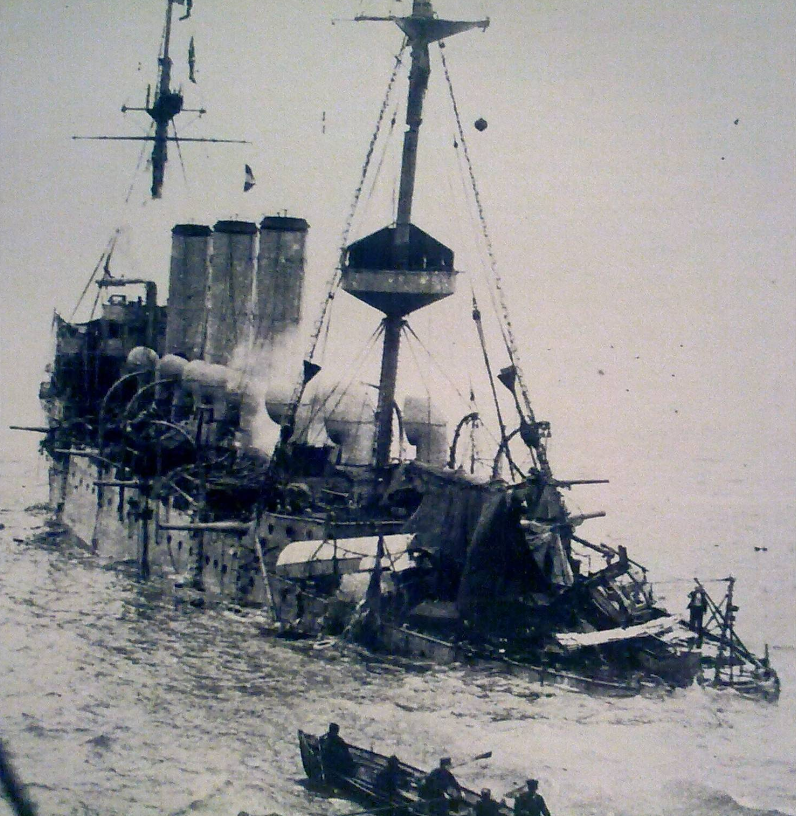The HMS Hermes began service as a flagship before it was modified to accommodate seaplanes, and eventually met a tragic end in the Straits of Dover. Five students from Barton Peveril Sixth Form College, aided by the research from volunteer Andrew Daw, share the story of this vessel which was lost 110 years ago today.
HMS Hermes was built as a second-class cruiser; the vessel displaced 5,600 tons, it was constructed of steel, with a length of 372ft (113.4m). The vessel was powered by a 4-cylinder triple expansion steam engine, which produced a total of 10,000 horsepower. It managed to reach the top speed of 20 knots, (37km/h; 23m/h). Hermes’ engines were powered by 18 Belleville boilers, and it carried a maximum of 1,143 tonnes of coal.
The ship was armed with 11 quick firing 6-inch guns that ranged to approximately 10,000 yards. There were other guns such as 8 quick firing 12 pounder cwt guns used for defence with another one of these with the ability to dismounted service onshore. The ship also included 3 six pounder Hotchkiss guns and two submerged 18-inch torpedo tubes. This shows that the ship was quite well equipped for battle especially in its short service in WW1.
HMS Hermes was historically significant, as it was converted to act as a seaplane carrier in 1913, able to store up to three planes and with a launch platform, it took part in experimental trials which were later used to help design HMS Ark Royal.

Figure 1: HMS Hermes, Source: Wrecskite
Time In Service
Under the command of Commander Charles L. Lambe (31st August 1913 to 31st October 1914), the HMS Hermes was built for war, with fourteen varied years of service. It was originally built in 1898 and completed in 1899. Beginning service as a flagship of the North America and West Indies station until late 1901, Hermes was then reduced to reserve and then commissioned back to work as a flagship. It wasn’t until March 1913 that Hermes was reduced to reserve under the Nore Command, where work then began in April of that same year, and it was modified to accommodate three seaplanes. This was achieved due to the removal of its forward six-inch guns so a tracked launching platform could be built over the forecastle, and a derrick being fitted to the forward mast to load aircrafts onto the vessel, making it the first experimental seaplane carrier of the Royal Navy. Following the trials, the aircraft equipment was removed, but then reinstalled in 1914 to allow the vessel to ferry aircrafts to France. It is unclear whether the launch platform or forward gun were reinstated at this time.
Hermes had been paid off on the 30th of December 1913, only to come back into service during the outbreak of WW1 as a seaplane tender, but then was recommissioned on 31 August 1914 under the Nore Command to ferry aircrafts and stores to France.
Sinking of HMS Hermes
On the 31st of October in 1914, the HMS Hermes was hit by two torpedoes from an enemy German submarine, the U-27 (Bernd Wegener), and sunk in the Straits of Dover 8 miles North-West off of Calais, France. It remains there today on the seabed. There was a total loss of 21 lives; however, most of the crew was saved. Hermes had been ordered out to sea before it was possible to add new life saving collars to the vessel, however, at the time of loss it was carrying 400 tins of petrol; as the ship was sinking the order was given to empty these and use them as floats and one crew member later reported that many of the survivors would have drowned had they not used the tins to float until help arrived. The ship sank in French territory which affects the way it can be explored now. The submarine that sank the HMS Hermes suffered the same fate in 1915 as it was sunk from gunfire.

Figure 2: The sinking of HMS Hermes, Source: Wrecksite
The Wreck
The HMS Hermes today is about 29-35m deep in the sea with the maximum depth being 32m and the highest part being 22m. It is said to be slightly inverted, and the port side is laying on the seabed. Although it is not covered in silt, there is many fishing equipment like nets and hooks around it. Certain areas like the stern and engine room are clear to explore and investigate. The wreck is classed to be in French territory so if there are people or organisations wishing to explore it, they must get permission from French authorities beforehand.
Ongoing Protection
The vessel is protected under the 2001 UNESCO Convention for the Protection of the Underwater Cultural Heritage (as France are a signatory), combined with the restriction from French authorities. Thanks to these restrictions and protection laws preserving the site, it was possible to prosecute several people accessing it without the right permissions, including two divers later arrested for stealing artefacts from the wreck. The theft of these artefacts from such a historical site also highlights the importance of protecting the heritage that lies beneath the ocean surface.
You can view the site of the HMS Hermes on our Forgotten Wrecks of the the First World War Interactive Chart.
